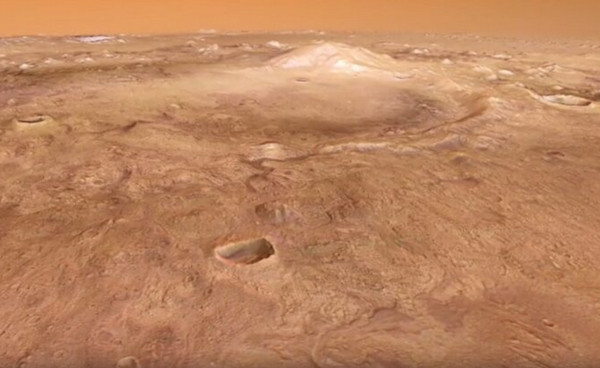 En combinant les données de sondes Mars Express et Mars Reconnaissance Orbiter, l’agence spatiale européenne (ESA) a reconstitué une vue aérienne 3D du cratère Jezero sur Mars, site où le rover Perseverance de la NASA s’est posé en février 2021 afin de rechercher des traces d’eau et de vie passée. Le site n’a pas été choisi au hasard puisqu’il a autrefois abrité un lac et que le delta qui s’y est formé présente des minéraux argileux attestant de la présence passée d’eau, et donc potentiellement de formes de vie.
En combinant les données de sondes Mars Express et Mars Reconnaissance Orbiter, l’agence spatiale européenne (ESA) a reconstitué une vue aérienne 3D du cratère Jezero sur Mars, site où le rover Perseverance de la NASA s’est posé en février 2021 afin de rechercher des traces d’eau et de vie passée. Le site n’a pas été choisi au hasard puisqu’il a autrefois abrité un lac et que le delta qui s’y est formé présente des minéraux argileux attestant de la présence passée d’eau, et donc potentiellement de formes de vie.
Perseverance envoie depuis plus de deux ans de magnifiques vues de son lieu de travail. Il y a quelques mois, l’ESA a diffusé la vidéo d’un survol de l’ensemble du cratère Jezero :

Image extraite de la vidéo
Jezero est un cratère d’impact de 49 km de diamètre situé dans un delta asséché à l’extrémité ouest d’Isidis Planitia, un bassin d’impact géant juste au nord de l’équateur martien. Sa formation remonte à environ 3,7 milliards d’années, ce qui en fait un site idéal pour la préservation de signes possibles de vie microbienne ancienne. Ce survol permet d’appréhender la topographie particulière de ce site et de mieux comprendre son intérêt scientifique.
La vidéo de l’ESA permet d’observer les trois vallées (Pliva Vallis, Neretva Vallis et Sava Vallis) qui traversent les parois du cratère et qui étaient autrefois des rivières. Le cratère est un « lac à bassin ouvert », c’est-à-dire que l’eau s’écoulait à l’intérieur et à l’extérieur du cratère.
Source : Science et Vie, space.com, ESA.
En compléments à cette note, vous pourrez lire l’article que j’ai écrit le 10 septembre 2022 sur ce blog à propos des roches découvertes par le robot Perseverance sur la Planète Rouge :

Roches volcaniques dans le cratère Jezero (Crédit photo: NASA)
——————————————————
 By combining data from Mars Express and Mars Reconnaissance Orbiter probes, the European Space Agency (ESA) has reconstructed a 3D aerial view of the Jezero crater on Mars, the site where NASA’s Perseverance rover landed in February 2021 in order to look for traces of water and past life. The site was not chosen at random since it was once home to a lake and the delta that formed there presents clay minerals attesting to the past presence of water, and therefore potentially forms of life.
By combining data from Mars Express and Mars Reconnaissance Orbiter probes, the European Space Agency (ESA) has reconstructed a 3D aerial view of the Jezero crater on Mars, the site where NASA’s Perseverance rover landed in February 2021 in order to look for traces of water and past life. The site was not chosen at random since it was once home to a lake and the delta that formed there presents clay minerals attesting to the past presence of water, and therefore potentially forms of life.
Perseverance has been sending great views of the site for over two years. A few months ago, ESA released the video of a flyover of the entire Jezero Crater:
Jezero is a 49-km diameter impact crater located in a dry delta at the western edge of Isidis Planitia, a giant impact basin just north of the Martian equator. Its formation dates back approximately 3.7 billion years, making it an ideal site for preserving possible signs of ancient microbial life. This overview allows us to see the particular topography of this site and to better understand its scientific interest.
The ESA video allows to observe the three valleys (Pliva Vallis, Neretva Vallis and Sava Vallis) which cross the walls of the crater and which were once rivers. The crater is an “open basin lake,” meaning water flowed in and out of the crater.
Source: Science et Vie, space.com, ESA.
In addition to this post, you can read the article that I wrote on September 10th, 2022 on this blog about the rocks discovered by Perseverance on the Red Planet:
